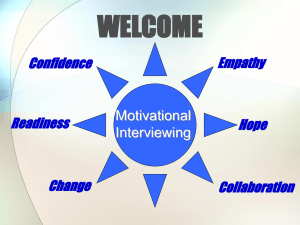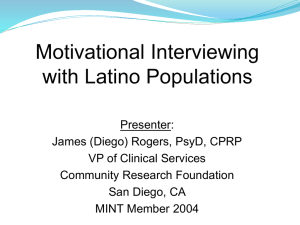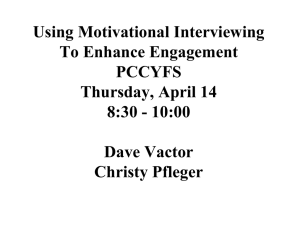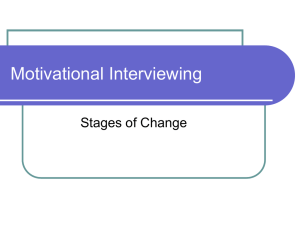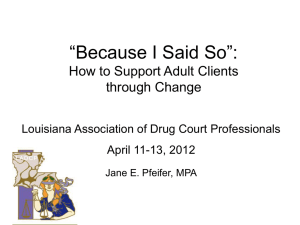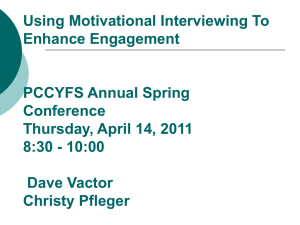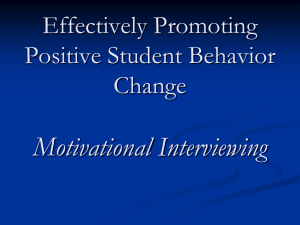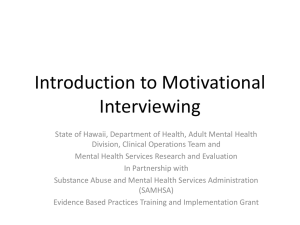TEACHER
advertisement
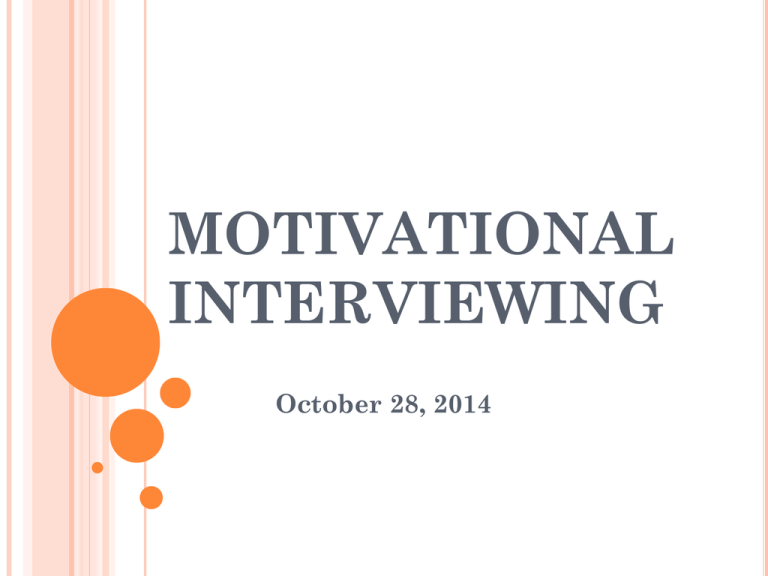
MOTIVATIONAL INTERVIEWING October 28, 2014 AGENDA Motivational Interviewing (MI) Overview and Skills Classroom Check-up (CCU) Practice INTRODUCTIONS Introduce yourself (name tags) Current Role - Clinician, Teacher, etc. Experience/training with Motivational Interviewing, Classroom Check-up and Family Check-up DISCUSSION QUESTION How much control do you have over whether teachers implement your recommendations? ACTIVITY Think of someone who had an important influence in your life, a favorite teacher, mentor, family member, etc. What personal qualities do you remember about them? PERSONAL QUALITIES Helpful Nonjudgmental Inspirational Self-assuredness Rationale High expectations Listener Nurturing Encouraging Credible Curious, probe Ask reflective questions Dynamic Believed in your potential Model Walk the talk Tenacious Well-respected SMALL GROUP DISCUSSION Have you ever lied/exaggerated . . . . . . to your dentist about how much you floss? . . . to your physician about how much you drink/ smoke/exercise? . . . to your teacher/professor about whether you did the readings for a class? Why? What could your dentist/physician/teacher have done to make it more likely that you would be more truthful? OBJECTIVES The Spirit of MI Apply motivational interviewing theory and techniques to coaching Discuss historical and conceptual foundations Identify key parts of effective, brief interventions Implement strategies for promoting teacher motivation Practice THE SPIRIT OF MI Client-centered Not just a set of techniques Carl Rogers - unconditional positive regard, empathy Collaborative Evocative Listening more than telling Respectful Honoring a person’s autonomy, resources Stages of learning MI See handouts: Eight Stages in Learning Motivational Interviewing (p. 1 & 2) Levels/Types of Training in Motivational Interviewing (p. 3) HISTORICAL FOUNDATIONS What is motivation, and what makes people want to change? We have great strategies for helping people change who have already made a decision that they want to change. Unfortunately, most people don’t come to us ready to change. Most of us are ambivalent about change. Ambivalence is normal. We need strategies to help people resolve their ambivalence. TRADITIONAL ASSUMPTIONS ABOUT MOTIVATION Clients are motivated to change If not, it’s hopeless Clients must want to change Motivation is dichotomous Motivation comes from within Motivation precedes behavior NEW ASSUMPTIONS ABOUT MOTIVATION Motivation is a state of readiness to change. Motivation fluctuates and can be influenced. Motivation involves interpersonal contact. The coach’s style is a powerful determinant of the client’s motivation. Ambivalence is a normal part of considering and making change and is not pathological. Each person has a potential for change. HOW PEOPLE CHANGE Studied change as it naturally occurs Desire to change is not dichotomous Stage of change predicted outcomes Redefined the problem (not resistance) Argued that different change strategies may be most effective at different points Prochaska, DiClemente, & Norcross, 1992 SPIRAL MODEL OF CHANGE Prochaska, DiClemente, & Norcross, 1992 Termination Maintenance Precontemplation HOW DO PEOPLE CHANGE? Often consultants try to persuade teachers to change by giving them facts, information, and logical arguments. Logic and factual information alone are not enough to get people to adopt new behaviors and routines! Research has shown increases in resistance when consultants use teaching (giving instructions or suggestions, providing rationale) and confrontation as opposed to when they used supportive comments (empathizing, paraphrasing, affirming). MOTIVATIONAL INTERVIEWING Developed by William Miller and Stephen Rollnick in 1980s Initially focused on problem drinkers in outpatient settings Used more recently in a variety of settings to promote health behavior change DEFINITION OF MI A directive, client-centered approach Enhances motivation for change by helping the client clarify and resolve ambivalence about behavior change. MI GOALS To create and amplify discrepancy between present behavior and broader goals To create cognitive dissonance between where one is and where one wants to be INGREDIENTS OF EFFECTIVE BRIEF INTERVENTIONS Personalized Feedback Responsibility Advice Menu of options Empathy Support Self-Efficacy GENERAL PRINCIPLES OF MI Develop Discrepancy Express Empathy Roll with Resistance Support Self-Efficacy READY, WILLING, AND ABLE Willing: The importance of change Able: Confidence to change Ready: Priority to change Miller & Rollnick, 2002 SPECIFIC MOTIVATIONAL INTERVIEWING STRATEGIES Negative Practice Use Your OARS Evoking Change Talk Responding to Change Talk Responding to Resistance NEGATIVE PRACTICE Roadblocks to Listening: What are some ways you can tell someone is not listening when you are talking? ROADBLOCKS TO LISTENING Ordering, directing, commanding Warning or threatening Giving advice, suggestions, solutions Persuading with logic, arguing, or lecturing Moralizing, preaching, telling what should do Disagreeing, judging, criticizing, blaming Agreeing, approving, praising Shaming, ridiculing, labeling Interpreting or analyzing Reassuring, sympathizing, or consoling Questioning or probing Withdrawing, distracting, humoring, or changing subject #1: NEGATIVE PRACTICE WITH ROADBLOCKS TO LISTENING Speaker role: Identify a real change that you are considering, something you are thinking about changing in your own life, but have not definitely decided (and feel comfortable discussing in role play). It will be something you feel two ways about. It might be a change that would be good for you, that you should make for some reason, but have been putting off. Tell the counselor about this change you are considering. #2: A Taste of MI Listener role: Don’t try to persuade or fix anything. Don’t offer advice. Instead ask these four questions one at a time and listen carefully to what the person says: 1. Why would you want to make this change? 2. If you did decide to make this change, how might you go about it in order to succeed? 3. What are the three best reasons for you to do it? 4. How important would you say it is for you to make this change, on a scale from 0 to 10, where 0 is not at all important, and 10 is extremely important? [Follow-up question: And why are you at _____ rather than a lower number of 0?] After you have listened carefully to the answers to these questions, provide a short summary of what you heard regarding the person’s motivations for change. Then ask one more question: 5. So what do you think you’ll do? and listen with interest to the answer. OARS OARS Open-ended questions Affirmations Reflections Summarize OARS Open-ended questions (can’t be answered in a single word): “What are your concerns about…? “Why do you want to make these changes…?” “How have you handled these problems in the past?” Affirmations (specific & genuine): “You’re really putting a lot of thought and time into this.” “I see how hard you are working” “You did an amazing job with praise this week!” OARS Reflective statements (strategy of paraphrasing comments while giving special attention to the implied feelings): “You’re really frustrated by how things are going.” “You’re having fun in your class.” “You just really want the best for these kids.” OARS Summaries (2 to 3 sentences to draw connections): “Let me make sure I am understanding all of the big ideas so far. You are feeling pretty worn out from all of the chaos in your classroom this year and taking on new classroom strategies just seems like another burden right now. At the same time part of you is hopeful that spending time on it now could eventually give you more time.” CHANGE TALK Counseling in a way that invites the person to make arguments for change Language that conveys a person’s desire, ability, reasons, need, or commitment to change Ask about/listen for: DARN Desire: want, prefer, wish Ability: able, can, could, possible Reasons: Why do it? What would be good? Need: important, have to, need to, got to LISTEN FOR CHANGE TALK Statements that indicate a need or willingness to change a behavior Concerns about the status quo “I’m worried that . . .” “If I don’t do something soon . . .” Advantages of changing “Things would be better if I . . .” Optimism about changing “I know I can do this . . .” Intention to change “I’m going to do this because . . .” Goal-setting “I’d like to improve my . . .” METHODS FOR EVOKING CHANGE TALK Asking evocative questions Using Importance and Confidence Rulers Elaboration See handout: 10 Strategies for Evoking Change Talk (p. 7) QUESTIONS THAT EVOKE CHANGE TALK Disadvantages of Status Quo What worries you about your ____? Advantages of Change How would you like things to be different? Optimism About Change What makes you think you could do it? Intention to Change What would you be willing to do? See handout: Questions that Evoke Change Talk (p. 8) IS IT CHANGE TALK? I’m worried that if I don’t get control of this class soon that I’m not going to make it through the year. It just seems like we’re wasting a lot of time this year waiting for students to settle down. Yeah, I know it’s important to have a fast pace, but you know this year I have the low group and I worry that they won’t be able to keep up. I would like to be better at setting limits with students. RESPONDING TO CHANGE TALK Elaborating change talk Reflecting change talk Summarizing change talk Affirming change talk CHANGE QUESTIONNAIRE Notice the language See handout: Change Questionnaire (p. 4) Tool to gauge readiness to change How would teachers respond? COMMITMENT TALK Special instance of change talk Intention to change See handout: Commitment Language (p. 9) Commitment talk towards end of session is the best predictor of whether people will change EFFECTIVE QUESTIONS “People are much more likely to do things THEY say they will do versus things that they are told to do.” “When the amount of change talk increases over the session or if it is more pronounced at the end of the session = better outcomes!” “Commitment language especially during the last 5 minutes of the meeting is the most predictive of CHANGE!!!” IMPORTANCE & CONFIDENCE RULERS How important would you say it is for you to _________? On a scale from 0 to 10, where 0 is not at all important and 10 is extremely important, where would you say you are? 0 2 4 6 8 10 Not at all Extremely Important Important Why are you at a ____ and not zero? What would it take for you to go from ___ to [a higher number]? And how confident would you say you are, that if you decided to _________, you could do it? On the same scale from 0-10, where would you say you are? 0 2 4 6 8 10 Not at all Extremely Important Important Why are you at a ____ and not zero? What would it take for you to go from ___ to [a higher number]? RESISTANCE Humans have a natural tendency to avoid persuasion and do not like to be told what to do. When we hear reasons why we should change, our minds automatically contemplate the reasons against change. Rule of thumb: If you hear yourself (consultant) arguing for change, do something different. You want the teacher to make the arguments in favor of change. GOOD LISTENING Teacher should be making 9 out of every 10 statements You can not get to the good stuff (values, change talk) without listening People will not listen to you if you are not listening to them!!! MI CLINICIAN SELF-ASSESSMENT REPORT See Handout Ongoing feedback, supervision Taping Sessions RESPONDING TO RESISTANCE Definition Simple reflection Amplified reflection Double-sided reflection Shifting focus Reframing Agreeing with a twist Emphasize personal choice and control Coming along side See Miller & Rollnick ROLLING WITH RESISTANCE Reflective Listening: Simple Reflections. When in doubt, use a simple reflection to acknowledge the person’s perspective or feeling. This invites further exploration, saps the energy of resistance, and avoids the trap of taking sides. TEACHER: I don’t get why we have to do this. I have been teaching for years and the kids just get worse and worse. CONSULTANT: It’s frustrating to put a lot of effort into doing this if people aren’t going to stick with it. PRACTICE Teacher: This child has me crazy. It is simply easier to send him to the office. ROLLING WITH RESISTANCE Amplified Reflections. Miller and Rollnick describe these as exaggerated reflections and note to be effective must be delivered in a matter-of-fact manner without hint of sarcasm. For instance: TEACHER: Those studies about effective classroom management really don’t prove anything. CONSULTANT: You really don’t believe research tells us anything about how to manage classrooms. PRACTICE Teacher: The kids in my class just don’t have parents that discipline them at home. The parents are the ones you should be talking to, not me. ROLLING WITH RESISTANCE Double-sided Reflections. These responses are excellent ways to respond to ambivalence. It involves including a summary of both sides of the ambivalence in a single response. Note that the preceding teacher statement does not necessarily need to include both sides of the ambivalence. That is, you may be reflecting the immediate response and drawing on prior teacher responses to put together these double-sided reflections. TEACHER: This intervention is just not going to work. CONSULTANT: I can see your predicament. On the one hand, you’re really worried about how things are going in your class (prior content), but on the other hand, you’re not sure how our work together can help. PRACTICE Teacher: I’ve tried my best and nothing is working. I am not really open to doing much more. ROLLING WITH RESISTANCE Shifting Focus. Rather than pushing forward through resistance (as it often invites us to do) a better tact is to acknowledge it and then shift attention to a new direction. TEACHER: You’re probably going to be mad at me for not teaching expectations this week. CONSULTANT: That’s really not why I’m here. What do you think would be helpful for us to discuss this week? PRACTICE Teacher: I know we talked about working on clarifying expectations in the classroom, but there were two snow days, then I was sick, and I just never really go to it. ROLLING WITH RESISTANCE Reframing. This classic counseling strategy offers a new, more positive, interpretation on a statement made by the teacher. TEACHER: I’ve tried so many classroom behavior plans but none of them seem to help. CONSULTANT: You’re very persistent in trying new things that can help. PRACTICE Teacher: I can tell when he has forgotten to take his meds and I know the whole day is awash. ROLLING WITH RESISTANCE Agreeing with a Twist. Miller and Rollnick describe this as a reflection with a reframe. The intent is to acknowledge the teachers’ position with a slightly differently spin or direction. TEACHER: I know how to teach these kids. No one can tell me what to do with them. CONSULTANT: You know a lot about what works here and really it’s completely up to you want happens in your classroom. If this is going to work, you need to be the key player in this process. PRACTICE Teacher: These students are in 4th grade and should know better. I don’t think I should have to babysit them by praising them for doing what they should be doing anyway. ROLLING WITH RESISTANCE Emphasizing Personal Choice. It’s common for people to respond with resistance when they feel their choices are limited or threatened. When consulting around getting teachers to adopt specific practices, this response is even more likely. The best response when you sense a teacher is threatened in this way is to simply state the obvious, that ultimately it’s their decision about what they do. TEACHER: My principal is making me do this. She really didn’t give us any choice. CONSULTANT: It seems like you have no choice here which is frustrating. When it gets down to it, though, what you do in your classroom and how you do it is really up to you. I can’t force you to meet with me. It’s your decision about how we spend our time together. PRACTICE Teacher: I wish he would just stop acting like a kindergartener. I shouldn’t have to check off boxes to get him to behave. ROLLING WITH RESISTANCE Coming Alongside. This is an advanced strategy for evoking change talk that involves having the consultant take the side against change. Much like reverse psychology, the rationale is that by arguing against change, the consultant makes it more like the teacher will respond by arguing for change. This should be used cautiously, especially as you are learning the method. As always, your best guide to whether it is working is whether or not it produces change talk. TEACHER: I don’t think these strategies are going to work. CONSULTANT: It’s seems pretty hopeless, like why even try if there’s a possibility it’s not going to work. or TEACHER: I’m going to give it a try this week and work on using these strategies every day. CONSULTANT: Hey, slow down. Are you sure you’re ready to do this? PRACTICE Teacher: I already know how to control my students behavior. ROLLING WITH RESISTANCE Evocative Responses. Remember the goal is to evoke change talk from clients, so other responses we discussed for doing this also apply to working with resistance. Often one of the above responses is the best initial response to resistance. But any of these can be followed with the methods we discussed for evoking change talk. Asking Evocative Questions: “Remind me again the reasons you wanted to make these changes…” Exploring Decisional Balance: “What are the pros/cons of keeping things the same and the pros/cons of doing something new?” PRACTICE Teacher: I don’t have time to work on this stuff. Do you have any idea what I am required to do each day? ROLLING WITH RESISTANCE Connecting Responses to Values: “This is really hard because of how much you really want to have a positive influence on these kids.” Look Forward or Back: Ask about a time in the past when things were different or to a time in the future when things will be better (e.g., what will happen if things continue as they are, how would you like your classroom to be this time next year). Ask the Miracle Question (e.g., if you could be 100% successful at doing this, what would be different). Query Extremes. “What are the worst things that might happen if you don’t make this change?” What are the best things that might happen if you do?” Change Rulers. As always, these are safe best for evoking change talk. In addition to Importance (need) and Confidence (ability) rulers, you can mix it up by asking about Desire (want) and Commitment. PRACTICE Teacher: It is just easier for me to send students out of the classroom when they are not listening. I don’t think I should have to waste time correcting them. THE CHECK-IN QUESTION Regularly assess the teacher’s reaction Use Check-in Questions liberally throughout conversations with teachers “What’s your reaction to that?” “Would it be helpful if I…?” “What do you make of that?” *The key is that you want to stay in touch with how the teacher is responding to new information that you have given him/her. ELICIT-PROVIDE-ELICIT (EPE) Simplified strategy to capitalize MI during brief social encounters Ask what the teacher/parent would like to know about the topic, then provide manageable/concise information based on their request. Next, ask for their response to the information Good entry question to begin the EPE process is, “What do you want to know about…” THE “WHAT NEXT?” QUESTION After eliciting change comments Ask: “What next?” “Now that you have all of the information on the table about why you want/need to change, what are you going to do?” “What do you think you will do now?” “So tell me the plan from here.” “What are you going to do?”
